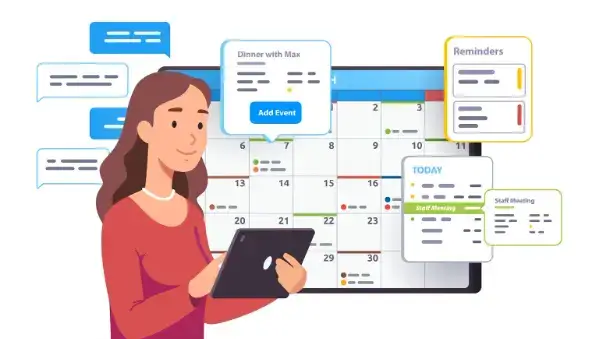Learning to schedule all business calls successfully is crucial for professionals and businesses looking to maximize productivity and efficiency.
This article delves into different approaches to simplify making sales calls, arranging gatherings, and overseeing telephone call communications.
From understanding your specific business needs to setting up and monitoring your phone system, we will break it down for you step by step. So, without further ado, let’s get right into it!
5 Steps to a Better Business Call System
- Understand Your Business Needs
- Choose The Right Virtual Business Phone System
- Set Up Your Virtual Business Phone System
- Automate Your Business Calls
- Monitor Phone System Performance
1. Understand Your Business Needs
To successfully schedule all business calls, it is crucial first to understand your specific business needs.
-
Identify your callers
Different businesses have different types of callers: clients, partners, vendors, or team members. Identifying who will call helps tailor a call scheduling system that caters to their requirements and preferences.
For instance, if most of your callers are international clients, World Clock Meeting Planner can help find suitable times for everyone involved.
-
Establish your goals
Setting clear goals for call scheduling allows you to prioritize tasks effectively and allocate resources accordingly.
Some common objectives include reducing missed calls, improving customer satisfaction rates, or streamlining internal communication processes within teams.
-
Determine your resources
- Staff availability: Assess how many team members handle incoming calls.
- Budget constraints: Consider any financial limitations by comparing service providers' various plans.
- Technical infrastructure: Evaluate your existing technical infrastructure to ensure compatibility with the chosen virtual business phone system.
Considering these factors will help you develop a comprehensive understanding of your business needs, which is essential for successfully scheduling all calls using a virtual phone system.

Source: Shutterstock
2. Choose The Right Virtual Business Phone System
To successfully schedule all business calls, selecting a virtual business phone system that meets your specific needs and requirements is crucial.
-
Consider features and benefits
When evaluating different virtual business phone systems, focus on the features they offer that are relevant to your organization's needs. Key aspects to consider:
-
- Call routing options: Ensure the system can route calls efficiently based on time of day or agent availability.
- Integration with other tools: Check if the system integrates seamlessly with popular calendar apps like Google Calendar or Microsoft Outlook for easier scheduling.
- Analytics capabilities: An excellent virtual phone system should provide insights into call volume trends, missed calls, and agent performance metrics.
- Mobile app support: Make sure a user-friendly mobile app is available to manage calls while you’re away from your desk.
-
Compare prices and plans
Different providers may offer various pricing structures depending on the number of users or the minutes included per month.
Take time to compare prices across multiple vendors to find one that fits within your budget while still providing necessary functionality.
For example, explore options like RingCentral and KrispCall, which offers flexible pricing plans for businesses of varying sizes.
-
Read reviews and testimonials
Before committing to a specific virtual business phone system, read reviews and testimonials from other users to gain valuable insight into potential issues or limitations.
Websites like G2 and Capterra offer user-generated reviews, allowing you to make informed decisions based on real-world experiences.
All in all, choosing the right virtual business phone system is vital to ensure the successful scheduling of all your business calls.

Source: Shutterstock
3. Set Up Your Virtual Business Phone System
Once you have identified the most suitable virtual business phone system for your company, it is time to begin configuring and establishing the system to ensure the smooth scheduling of all calls.
-
Create an account and choose a plan
First, create an account with your selected provider to begin setting up your virtual business phone system. During this step, carefully review available plans and pricing options to find one that aligns with your budgetary constraints and feature requirements.
-
Configure settings and preferences
After choosing a suitable plan, proceed by configuring various settings within the virtual business phone system interface.
-
- Call forwarding: Set rules for directing incoming calls to specific team members or departments based on criteria like caller ID or time of day.
- Greeting messages: Record personalized greetings that play when callers reach your main line before being routed accordingly.
- Voice menus (IVR): Create interactive voice response menus allowing callers to navigate options using their keypad or voice commands.
- Scheduling preferences: Determine availability hours for incoming calls.
These configurations will help ensure a smooth and professional experience for your callers and team members.
-
Connect to other services
If your virtual business phone system offers integration with other services, such as CRM software or calendar applications, utilize these connections to streamline call scheduling processes further.
Doing so can save time and also decrease potential mistakes that may arise from manual data input. Setting up your virtual business phone system is essential to ensure you efficiently manage all your calls.

Source: Shutterstock
4. Automate Your Business Calls
Scheduling your business calls can be a breeze using the right tools and strategies.
-
Automate scheduling processes with software tools
Using software tools like Calendly, POWR Appointments, Acuity Scheduling, or ScheduleOnce can help streamline booking appointments and managing call schedules.
These platforms allow clients or colleagues to book time slots based on your availability and also offer integrations with popular virtual business phone systems.
-
Utilize calendar integration for seamless scheduling
Calendar integration ensures that everyone can access accurate information about the appointment and minimizes the risk of scheduling conflicts.
Luckily, most virtual business phone systems offer integration options with popular calendar applications such as Google Calendar, Microsoft Outlook, or Apple iCal.
-
Leverage automated reminders for improved efficiency
In today’s age, most virtual business phone systems offer built-in reminder features that allow you to customize your reminders.
Utilizing automated reminders through email or SMS notifications can help reduce no-shows and last-minute cancellations. To do so, consult the right support resources for guidance.
By implementing these strategies and using a reliable virtual business phone system, you'll be well-equipped to manage your call schedule seamlessly.
Integrating AI appointment setting tools can significantly improve the overall organization of your call schedule.
-
Integrate AI into your business calls
An AI meeting assistant plays a crucial role in ensuring successful business calls by providing numerous benefits and enhancing overall productivity.
Its ability to transcribe and summarize online meetings is of utmost importance for successful business operations.
AI meeting recorder for sales calls on Google Meet and Zoom is a valuable tool for sales professionals looking to enhance their performance.
This innovative software leverages artificial intelligence to capture and transcribe sales conversations, providing a comprehensive record for review and analysis.
By using AI Meeting Recorder, sales teams can improve their communication skills, identify areas for improvement, and gain valuable insights that lead to more effective sales strategies.
Firstly, automatic meeting transcription provides a reliable record of the meeting, capturing crucial details, decisions, and action items. This eliminates the need for extensive note-taking and ensures that participants have a comprehensive reference for future follow-ups.
5. Monitor Phone System Performance
Monitoring the performance of your virtual business phone system is essential for ensuring its effectiveness and making improvements as needed.
-
Track call volume and usage patterns
It's crucial to track call volume and usage patterns over time. You can use built-in data analytics tools from most virtual business phone systems or third-party applications like CallRail to collect this data.
-
Analyze data
Data analysis is crucial when monitoring the performance of a virtual business phone system, considering that it helps uncover areas of improvement or growth.
Some key metrics to analyze include average hold time, average talk time, and call abandonment rate.
You can also use data analysis to identify customer inquiries and preferences trends. By using the insight gathered from customer inquiries and preferences, businesses can optimize their operations to meet customer needs better.
-
Adjust settings
Once you've identified areas of improvement or growth through data analysis, it's essential to adjust the settings of your virtual business phone system accordingly. Here are some potential adjustments:
-
- Change routing rules to ensure the most appropriate team members receive their calls
- Adjust hold music or messaging options if customers have expressed dissatisfaction with these elements.
- Incorporate additional features like auto-attendants or interactive voice response (IVR) systems to enhance caller experiences.
Regular monitoring will allow you to continuously optimize your virtual business phone system's performance over time, ensuring a positive experience for both callers and employees.
Staying aware of advancements in the tech field is essential for keeping up with progress and making further enhancements as needed.

Source: Shutterstock
As a professional, scheduling business calls is essential to your work. Here are some tips to help you master the task at hand successfully.
5 Steps to Successfully Schedule All Business Calls
- Identify Participants and Availability
- Choose The Best Time
- Use Calendar Applications or Meeting Scheduler Apps
- Send Invitations
- Respect Personal Boundaries
1. Identify Participants and Availability
You can use scheduling software or calendar integration tools to make this process easier. Before scheduling a call, identify all the participants and their availability. It will help you find a suitable time for everyone involved.
2. Choose The Best Time
The best time to make business calls is between 9 AM and 5 PM in your recipient's local time zone.
However, it may vary depending on individual preferences and work schedules. Consider using time zone converters when scheduling international calls.
3. Use Calendar Applications or Meeting Scheduler Apps
You can schedule calls by utilizing calendar applications like Google Calendar or Microsoft Outlook to create events with specific dates and times.
You can also use dedicated meeting scheduler apps, which help automate finding mutually convenient times for all participants.
4. Send Invitations
Once you have identified the participants and chosen a suitable time, send out invitations with the date, time, and dial-in information to ensure that all parties are informed. You can create the best invitations with the help of an invitation maker app.
5. Respect Personal Boundaries
Call customers before 8 AM in their local timezone if they have specifically requested an earlier contact time. Respecting people's boundaries while maintaining professionalism during working hours is essential.
Following these tips, you can successfully schedule all your business calls and ensure everyone is informed and available. Happy calling!
Conclusion
In conclusion, successfully scheduling all business calls requires you to understand your business needs thoroughly, choose the right virtual phone system, set it up properly, and leverage automation tools to streamline the scheduling process.
Be sure to monitor performance over time to make adjustments and optimize efficiency.
At Messaging Service, we offer a reliable and affordable virtual phone system with features like automated scheduling and reminders.
Sign up for Messaging Service's virtual phone system today to improve your business’s communication processes like never before!


